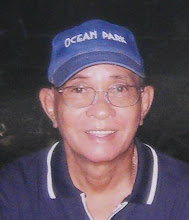F. SANGHIYANG
Among articles and write-ups coming out of books and magazines, I often encounter that “SAYAW SA APOY” is also called “SANGHIYANG”. This is wrong because based on what I have personally seen and according to those who are involved in doing them, “SANGHIYANG” & “SAYAW SA APOY” are two distinct rituals.
“Sayaw sa Apoy” is only a part or additional show to glamorize the performance of the “Sanghiyang” which could be performed separately. “Sayaw sa Apoy”, however, cannot be done without first doing “Sanghiyang” as preliminary ritual.
“Sanghiyang” is actually a ritual of Ancestral Offering based on the Old Testament. This is always done in preparation for other rituals such as Firewalking or Fire Dancing. “Basang-Gilagid”, guiding to eternal rest one who died, or healing someone bewitched.
It is also performed before searching for a lost item, such as jewelry and other valuables. After it, the “Barka” (or Magsasanghiyang) dialogues with the Superpower through her “Timbangan” (pendulum)
SAYAW SA APOY
As noted by Alejandro Roces, "In Alfonso, Cavite, there is a Barrio called MARAHAN where there lives an exclusive sect that perform a cultic ritual known as SANGHIYANG. This ritual used to be a pagan rite of ancestral worship but was later imbued with Christian connotations and biblical justification". Presently, it is being practiced not only as a form of ancestral worship but also as preparation of mediumtistic healing and a preliminary rite for a more colorful ritual called SAYAW SA APOY (Dance on Fire).
The original dancers claimed that SAYAW SA APOY actually started during the time of Noah, immediately after the Universal Deluge. (Gen, VIII:20) “And Noah built an altar unto the Lord and taking of all cattle and fowls that were clean, offered holocaust upon the altar.” This very act of Thanksgiving was handed down from generation to generation, and how it reached Alfonso, specifically Barrio Marahan, God only knows.
These Fire Dancers call themselves “BARCO”, meaning boat, signifying Noah’s Ark. How one becomes a “barco” is an interesting process that takes years of trials and spiritual exercises. This consists of several stages:
FIRST; “ANG PAG-AABOT NG TIMBANGAN” or the giving of the scale. The “TIMBANGAN” here is not like any of the measuring scales we find in the market. It is actually a chain necklace usually hanging one of several antique medallions which are considered amulets.
SECOND; “ANG PAGPAPASPAS” or the symbolic cleansing stage whereby the potential “barco” is fanned all over with a leafy branch of “Balas-hari” or “Baston ni San Jose” (Scientific name: Cordiline terminals).
THIRD; The “CORONATION” which is the final stage, after it the candidate is considered a full fledge “barco” of “barca”. This is the most colorful stage and an occasion for lavish feast. A “barco” automatically becomes a potential fire dancer aside from so many other special functions he can perform.
During the Spanish time this Fire Dancing Ritual was performed often during Barrio Fiestas and whenever there was an occasion for Thanksgiving. Sometime in 1921 Mr. Hammond Buck, a Thomasite teacher, noticed this group and brought them to Australia.
They performed there for one year but the skeptic Australian for failure to find a better explanation branded the dancers evil and considered the rite “satanic”. None of the group is still alive today and the dancers now are their descendants. Like their parents and grandparents, our present 'magsasayaw sa apoy' are all practicing Roman Catholics and ordinary people of good moral character. It is surprising why observers usually have a tendency to look at the negative aspects of things. In this particular case if we focus our attention and thinking on the negative side of fire we shall find nothing but hell and the devil. But let us not forget that for many occasions, God manifested Himself in the FORM OF FIRE. (see Exodus 111:2 =And the LORD APPEARED TO HIM IN A FLAME OF FIRE…” Acts 11:3 =and there appeared to them parted tongue as if it were of fire…; Exodus XIII:21 = and the Lord went before them to show the way by day in a pillar of cloud, and by night in a PILLAR OF FIRE…: Ecclesiasticus XLVIII:9 = who was taken up in a WHIRLWIND OF FIRE; in a chariot of FIERY HORSES).
The original seven dancers who went to Australia were also presented by Mr. Buck at the carnivals but the people thought the fire was artificial and the show did not click. Somehow the dancers grew old and got tired. The performances became more infrequent and was almost forgotten, then until the First Lady, Mrs. Imelda Marcos started reviving Filipino traditions and cultural heritages.
The interest in the Mystical Show was revitalized and gained new momentum. A group was organized under the leadership of Mang Edilberto Alvarez and Aling Eufrocina Hernan, both of Barrio Marahan, Alfonso, Cavite. While their performances were not as fantastic as that of the original group, they are magnificent and just as unbelievable.
The Fire Dancers use a special formula of prayer which I am not supposed to reveal and indeed, there is more to this show than just fire, smoke and glowing coals.
As Mr. Alejandro Roces said during one of his lectures, “In this scientific age, it is stupid to believe that people can walk on fire; more stupids is not to believe when you see that it is happening.
To see is to believe and to believe is to accept and to surrender. Whatever is behind this rite is a reality that we have to accept. There is a POWER BEYOND OUR COMPREHENSION and anything beyond our comprehension is something no one can attempt to fully explain.
From the book TINGKORAW: Alfonso's History and Legend by jett e. avinante,m.d.
Subscribe to:
Post Comments (Atom)

1 comment:
available po ba yung Tingkoraw sa national bookstore?
Post a Comment